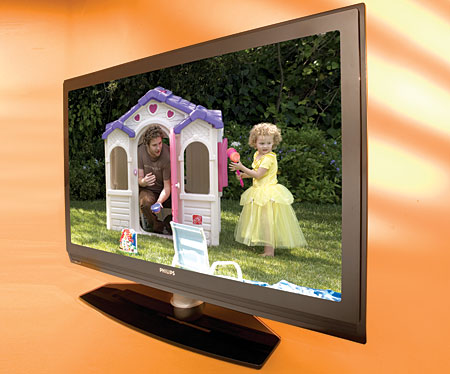LCDs From Sony, Samsung, Toshiba & Philips Philips 47PFL9732D LCD HDTV
This 47-inch 1080p display employs all of Philips' advanced technologies, yet its $2,799 asking price is about $800 less than that of its closest competitor in this roundup, which has a smaller screen size. It doesn't have the advanced customization and picture controls of the other TVs, but it still boasts an impressive features list.

Philips understands that most people don't bother to set up their TVs. Thus, the company created a Settings Assistant that, when you first power on the TV, shows a series of split-screen options, asking you to pick which one you prefer. When completed, the TV automatically adjusts things like picture mode, color temperature, and general video settings to suit your preferences. Major kudos to Philips for taking this step.
 The connection panel is thorough, including three HDMI inputs and a USB port for music/photo playback, and the onscreen menus are easy to navigate. The TV has a basic-black aesthetic but does include a swiveling base; the silver remote, meanwhile, is a model of simplicity with limited backlighting but no dedicated source buttons. Of course, the TV also includes Philips' Ambilight, with options to precisely adjust the color, brightness, and balance.
The connection panel is thorough, including three HDMI inputs and a USB port for music/photo playback, and the onscreen menus are easy to navigate. The TV has a basic-black aesthetic but does include a swiveling base; the silver remote, meanwhile, is a model of simplicity with limited backlighting but no dedicated source buttons. Of course, the TV also includes Philips' Ambilight, with options to precisely adjust the color, brightness, and balance.
Years ago, Philips' PixelPlus processing was the first to make film look more like video, which drew both praise and ire. Now PixelPlus is gone, and Philips employs two new technologies, 120-Hz and ClearLCD, to improve motion in this TV. With each of my motion test patterns and demo scenes, I turned these options off and on; when they're employed, I saw a slight reduction in motion blur, yet the 47PFL9732D still rendered natural, film-like motion that pleased my roundup cohorts, Geoffrey Morrison and John Higgins.
In other processing respects, the Philips created very few deinterlacing artifacts in our 480i Gladiator scene through both the component and HDMI inputs. Upconverted 480i sources had good detail as well, although there was noticeable edge enhancement through the component video input. With our 1080i Silicon Optix HQV Blu-ray disc, the 47PFL9732D did not correctly deinterlace 1080i with the static video-resolution test, but it did a fine job with the moving film-resolution test, correctly deinterlacing the signal and picking up 3:2. With real-world 1080i HDTV and high-def DVDs, I didn't notice blatant artifacts. The HDMI inputs accepted 1080p/60 but produced choppy motion with 1080p/24. (We had a preproduction sample; Philips says the TV does accept 1080p/24 through HDMI.)
This TV had the most even color temperature and measured close to D6500 out of the box, except with dark content, which was fairly cool. You can access white-balance controls directly from the user menu, and it measures even better after calibration. Its red and blue color points are fairly accurate, but green is highly oversaturated, causing the overall color palette to be somewhat greenish-blue. Oversaturated greens remained a constant in this roundup; the difference here is that, while the more expensive TVs have advanced color options that help dial in a more accurate green, this model does not. Still, when judged on its own, the Philips had pleasing colors and generally natural skintones.
Its processing, color, detail, and good bit depth combine to produce clean, nice-looking DVD and high-def images. The 47PFL9732D's only real hindrance is a lower contrast ratio that prevented the image from having as much depth and richness as the other TVs. This display doesn't have an adjustable backlight, relying only on a light sensor that automatically adjusts its brightness based on room conditions. Turning this feature off limits both black level and light output, so you should definitely keep it on. Even then, the TV wasn't as bright as the others in a well-lit room, nor were its blacks as deep in a darkened room with demo scenes from Batman Begins and V for Vendetta. A 0.023-foot-lambert black level is pretty good for an LCD, but it was the highest in this particular roundup. . . although, as you'll see, some of the other companies' numbers can't be trusted. Regardless, the eyes don't lie, and the Philips' image clearly wasn't as saturated or rich in a dark room, nor was the viewing angle very wide (two common LCD drawbacks).
Despite some limitations, we were all favorably impressed by the 47PFL9732D's performance. It may not be the videophile's choice, but its well-rounded features and good performance make an appealing choice for a general-use TV.























































